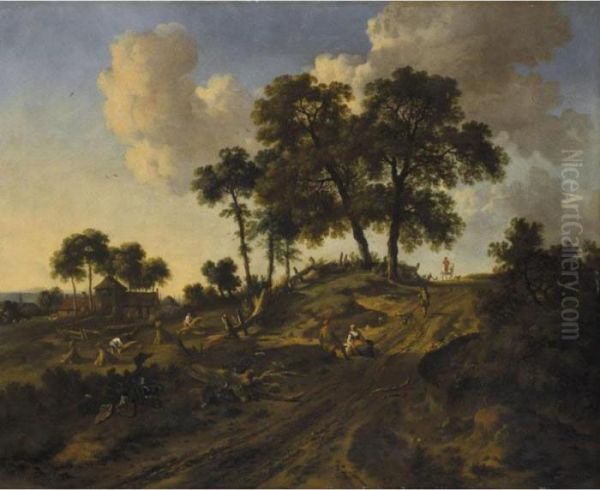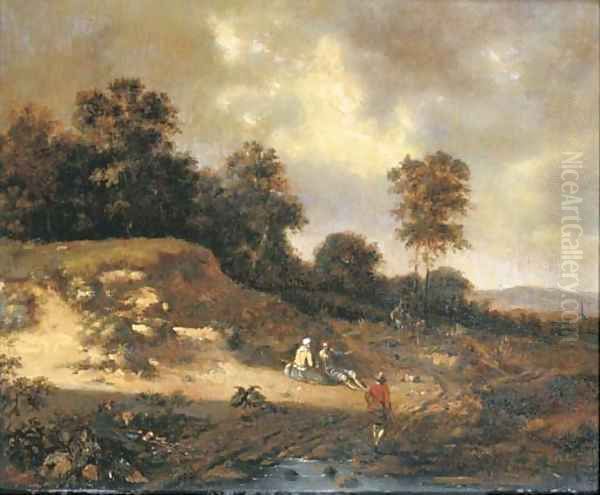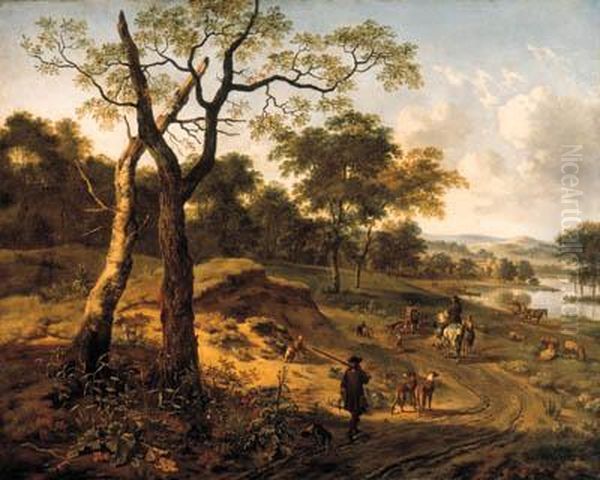Introduction: A Golden Age Talent

Jan Wijnants (born c. 1631/1632, Haarlem – buried January 23, 1684, Amsterdam) stands as a significant figure in the rich tapestry of Dutch Golden Age painting. Active during a period of extraordinary artistic flourishing in the Netherlands, Wijnants carved a distinct niche for himself as a specialist landscape painter. He possessed a remarkable ability to capture the specific character of the Dutch countryside, particularly its dunes, sandy tracks, and distinctive vegetation.
Born in Haarlem, a major centre for art production, and later working in The Hague and Amsterdam, Wijnants's life reflects the mobility and entrepreneurial spirit of artists in his time. Unusually, alongside his successful painting career, he also operated as an innkeeper in Amsterdam, a dual profession not uncommon for artists seeking financial stability in a competitive market. His legacy lies in his detailed, evocative landscapes that influenced subsequent generations, even though his own life was marked by periods of financial strain.
Early Life and Artistic Formation in Haarlem
Jan Wijnants entered the world in Haarlem, likely in 1631 or 1632. His father, also named Jan Wijnants, was an art dealer, placing the young Wijnants directly into the vibrant artistic milieu of the city from an early age. Haarlem was then a powerhouse of landscape painting, home to masters who were pioneering new ways of depicting the local environment with unprecedented realism and sensitivity.
Details about Wijnants's formal training remain somewhat scarce. While his father's profession undoubtedly provided exposure to art, identifying his specific teachers is complex. Some early works suggest a possible connection or collaboration with a Dirck Wijnants, perhaps a relative, as seen in a work like The Hut (1654). It's highly probable that he absorbed influences from the prevailing Haarlem landscape tradition.

Later sources, like Arnold Houbraken's "De groote schouburgh der Nederlantsche konstschilders en schilderessen" (1718–1721), mention connections to other artists, though these accounts must be treated with caution as they were written decades after Wijnants's death and sometimes contain inaccuracies. Figures like the landscape painter Nicolaes de Vries and the versatile Philips Wouwerman, known for his scenes with horses and figures, are sometimes suggested as potential influences or even teachers. Wouwerman's presence in Haarlem certainly makes him a plausible candidate for interaction. Regardless of specific tutelage, Wijnants rapidly developed a distinctive style focused on the careful observation of nature.
The Hague and the Move to Amsterdam
Wijnants's presence is documented in The Hague by the late 1650s, where he continued to develop his landscape painting. However, a significant shift occurred around 1660 when he relocated to Amsterdam, the bustling economic and cultural heart of the Dutch Republic. This move marked a new phase in his personal and professional life.
Shortly after arriving in Amsterdam, on December 12, 1660, Jan Wijnants married Catharina van der Veer at a location on the Runstraat. This marriage, however, seems to have coincided with, or perhaps contributed to, a period of financial instability for the artist. Documents from the time reveal that Wijnants frequently faced monetary difficulties and was pursued by creditors.
In Amsterdam, Wijnants diversified his activities by becoming an innkeeper or tavern owner, likely operating near the Herengracht. This business venture, while common for artists seeking supplementary income, did not entirely alleviate his financial woes. City records mention lawsuits and debt issues on several occasions. A document from 1667 even details notary Jacobus Hellerus overseeing aspects of the couple's finances, appointing Jan as a steward of his wife's affairs under specific conditions, suggesting complex financial arrangements or difficulties. His family connections also extended through his father's remarriage, making him a step-brother to the painter Jasper Jansz van Heemskerck. He also maintained connections within the Amsterdam art scene, associating with figures like Nicolaes de Verneuil.
The Wijnants Landscape Style: Dunes, Trees, and Light
Jan Wijnants developed a highly recognizable landscape style, celebrated for its meticulous detail and focus on specific natural elements. His preferred subjects were the rolling dunes near Haarlem, sandy country roads winding through undulating terrain, and distinctively rendered trees, often gnarled, dead, or sparsely leafed. He avoided the dramatic mountain vistas or idealized pastoral scenes favoured by some contemporaries, concentrating instead on the tangible reality of the Dutch environment.

His technique involved careful, almost microscopic, attention to texture. He excelled at rendering the gritty feel of sand, the rough bark of trees, and the delicate forms of weeds and grasses lining the roadsides. A characteristic feature is the presence of a prominent, often centrally placed tree, sometimes dead or decaying, which some art historians interpret as a vanitas symbol, a subtle reminder of life's transience amidst the enduring landscape.
Wijnants was a master of light. His scenes are typically bathed in a clear, bright daylight, often casting sharp, well-defined shadows that emphasize the contours of the land. While this clarity lends his work a sense of immediacy and realism, some critics have noted that his intense focus on detail can occasionally detract from a broader sense of atmospheric unity or aerial perspective. Later in his career, a subtle Italianate influence can sometimes be discerned, perhaps in the warmth of the light or certain compositional arrangements, reflecting a broader trend in Dutch art.
A Collaborative Canvas: The Role of Staffage
A fascinating aspect of Wijnants's working method was his frequent collaboration with other artists, particularly for the addition of figures and animals (known as staffage) to his landscapes. While Wijnants was the undisputed master of the landscape setting itself, he often relied on specialists to populate his scenes with shepherds, hunters, travellers, and livestock. This was a common and efficient practice in the highly specialized Dutch art market of the 17th century.
Several prominent artists are known to have collaborated with Wijnants. His own student, Adriaen van de Velde, who became a renowned landscape and animal painter in his own right, frequently added elegant figures and animals to Wijnants's compositions during his formative years. Their styles complemented each other well, with Van de Velde's graceful figures fitting seamlessly into Wijnants's detailed settings.
Another key collaborator was Philips Wouwerman. Given Wouwerman's fame for depicting horses, battles, and genre scenes, his contribution likely involved more dynamic figures, perhaps travellers on horseback or hunting parties, adding narrative interest to the landscapes. The versatile Johannes Lingelbach, known for his Italianate genre scenes and architectural paintings, also provided staffage for Wijnants, bringing a slightly different, sometimes more Mediterranean, flavour to the figures. This collaborative approach allowed Wijnants to focus on his primary strength – the landscape – while ensuring the finished works featured high-quality figurative elements.
Signature Works and Recurring Themes
Jan Wijnants produced a considerable body of work, much of which revolves around his core themes. His paintings offer variations on the Dutch landscape, showcasing his consistent style and preferred motifs.

Among his most notable works is Herengracht, Amsterdam (c. 1661, Cleveland Museum of Art). This painting is somewhat unusual for Wijnants as it depicts a specific, identifiable urban topography rather than a generic country scene. It demonstrates his skill in precise observation and rendering, capturing a view of the famous Amsterdam canal with meticulous detail.
More typical are his numerous dune landscapes, such as Dünenlandschaft mit Teich (Dune Landscape with Pond) and Dünenlandschaft mit Jägern (Dune Landscape with Hunters). These works epitomize his focus on sandy terrains, sparse vegetation, winding paths, and often feature a prominent, carefully delineated tree. The interplay of sunlight and shadow across the undulating dunes is a hallmark of these compositions.
Wooded landscapes also form a significant part of his oeuvre. A Wooded Landscape with Huntsmen on a Track showcases his ability to depict denser foliage while still maintaining clarity and detail. The characteristic sandy track leads the viewer's eye into the scene, often populated by small figures provided by collaborators. Works like Peasants Driving Cattle and Sheep and Countrymen Talking in a Field place genre elements within his typical landscape settings, illustrating rural life.
Coastal elements appear in works like Seaside Tree (National Gallery, London), where the proximity to the sea influences the vegetation and atmosphere. The Hut (1654), possibly an early work or collaboration, represents the simpler, rustic structures often found nestled within his landscapes. These representative works, studied by institutions like the Stuttgart Academy of Art and Design for their technique, consistently highlight Wijnants's dedication to rendering the specific textures and light of the Dutch natural world.
Wider Influence and Artistic Context
Jan Wijnants operated within the broader context of Dutch Golden Age landscape painting, a genre that reached unprecedented heights during the 17th century. He stands alongside other great masters who specialized in depicting their native land, such as the celebrated Jacob van Ruisdael, known for his often more dramatic and emotionally charged landscapes, and Meindert Hobbema, famed for his idyllic wooded scenes, particularly avenues of trees. While perhaps not reaching the same level of dramatic intensity as Ruisdael, Wijnants offered a distinct vision, characterized by its clarity, detail, and focus on specific terrain types.

Wijnants's influence extended beyond his immediate circle and the borders of the Netherlands. His detailed yet accessible style found particular favour in England during the 18th century. The great English portraitist and landscape painter Thomas Gainsborough was a known admirer of Wijnants's work. Gainsborough studied and copied Dutch landscapes, and elements of Wijnants's approach – particularly the rendering of trees, sandy banks, and country roads – can be detected in Gainsborough's own landscape paintings and drawings.
His influence also reached Germany, where the painter Wilhelm von Kobell, active in the late 18th and early 19th centuries, drew inspiration from Dutch masters, including Wijnants. The clarity, detailed rendering of terrain, and the quality of light in Wijnants's work resonated with artists seeking to depict landscape with precision and naturalism. Thus, Wijnants played a role in shaping the course of landscape painting not only in the Netherlands but also abroad.
A Reputation Reclaimed: Rediscovery in the 19th Century
Despite his success and influence during his lifetime and the following century, Jan Wijnants's reputation experienced a period of relative decline. As artistic tastes shifted, the detailed realism of Dutch Golden Age painters sometimes fell out of favour compared to grander historical or mythological subjects, or later, the looser brushwork of Romanticism and Impressionism.
However, the 19th century witnessed a significant revival of interest in Dutch 17th-century art, and Jan Wijnants's work was reassessed and appreciated anew. Several factors contributed to this resurgence. The enduring influence of his style, particularly on British landscape painting via artists like Gainsborough, kept his name alive among connoisseurs and collectors in the UK, a key market for Dutch art.
The burgeoning field of art history began to systematically study and catalogue the Dutch masters, recognizing Wijnants's specific contribution as a specialist in dune and country road landscapes. His technical skill and unique focus were highlighted in scholarly publications. Furthermore, the art market itself played a role. As major public and private collections were formed across Europe and America, there was a renewed demand for high-quality works from the Dutch Golden Age. Museums actively sought out paintings by artists like Wijnants. For instance, the prestigious Mauritshuis in The Hague acquired works by him in the early 20th century (e.g., 1903), cementing his status as an important figure worthy of national collections. This combination of artistic influence, scholarly attention, and market demand ensured that Jan Wijnants was reclaimed from relative obscurity and his place in art history secured.
Wijnants in Collections and the Market Today
Today, the works of Jan Wijnants are held in numerous prestigious museums and art galleries around the world, testament to his enduring appeal and historical significance. Major institutions housing his paintings include the Rijksmuseum in Amsterdam, the Mauritshuis in The Hague, the National Gallery in London, the Cleveland Museum of Art, the Museum of Fine Arts in Boston, and the Philadelphia Museum of Art, among many others. These collections allow the public to appreciate the quality and consistency of his distinctive landscape style.
Beyond museum walls, Wijnants's paintings continue to appear on the international art market, demonstrating ongoing interest from private collectors. Auction records show regular sales of his works. For example, a landscape featuring a country path was sold at the Neumeister auction house in 1999 and later reappeared at Sotheby's in London in 2012. Another piece, A Wooded Landscape with Huntsmen on a Track, noted as being in a German private collection since the 1990s, indicates the desirability of his work among collectors. A painting depicting a coastal scene with fortifications was offered at auction in 2020 with an estimate of €8,000–€12,000. The continued presence of his works in both public institutions and private hands underscores the lasting value attributed to his meticulous depictions of the Dutch landscape.
Conclusion: A Master of Detail and Place
Jan Wijnants occupies a specific and important place within the constellation of Dutch Golden Age landscape painters. While perhaps less famous than contemporaries like Jacob van Ruisdael, his contribution was distinct and influential. He excelled as a specialist, focusing his artistic vision on the dunes, sandy paths, and characteristic trees of the Dutch countryside, rendering them with exceptional detail and a masterful handling of light.
His practice of collaborating with other artists for figures highlights the specialized nature of the 17th-century Dutch art world. Despite facing personal financial challenges and juggling his art with the demands of innkeeping, Wijnants produced a consistent and high-quality body of work. His paintings offered a clear, tangible vision of the Netherlands' natural environment that resonated with contemporaries and influenced later generations of artists, particularly in England and Germany.
Forgotten for a time but rediscovered and appreciated anew from the 19th century onwards, Jan Wijnants remains a key figure for understanding the depth and variety of Dutch landscape painting. His works, found today in major museums worldwide, continue to engage viewers with their meticulous realism and evocative portrayal of place. Jan Wijnants died in Amsterdam and was buried on January 23, 1684, leaving behind his wife, four children, and a significant artistic legacy as a dedicated chronicler of the Dutch landscape.